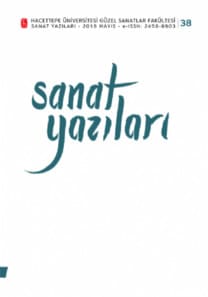İÇ MİMARLIK DİSİPLİNİNDE STAJ UYGULAMASI SORUNLARININ BELİRLENMESİ*
: Bu çalışma, İç Mimarlık staj uygulamasının sorunlarını tespit etmeyi amaçlamaktadır. Araştırmanın katılımcıları Türkiye’de bir devlet üniversitesinin İç Mimarlık lisans bölümü 4. Sınıf öğrencileridir (22 öğrenci). Bu araştırmada nitel araştırma yöntemlerinden fenomenolojik yaklaşım kullanılmıştır. Veriler betimsel analiz yoluyla değerlendirilmiştir. Elde edilen bulgulara göre İç Mimarlık öğrencilerinin karşılaştıkları sorunlar mesleki gelişim sorunları ve kişisel gelişim sorunları olarak ofis ve şantiye staj türleri altında gruplandırılmıştır. Buna göre mesleki gelişim açısından ofis stajında bilgisayar destekli uygulamaların yeteri kadar deneyimlenememesi ve staj yapılan firmaların özgün tasarım beklentisinin olmadığı sorunları göze çarpmaktadır. Şantiye stajında deneyimlenen malzeme çeşitliliğinin yetersiz oluşu ve uygulama süreçlerinin baştan sona takip edilemediği sorunları öne çıkmaktadır. Kişisel gelişim açısından ofis ve şantiye stajlarında stajyere proje sorumluluğunun verilmemesi ve stajyerden teknik bilgi anlamında beklentinin fazla olması nedenleriyle yaşanan motivasyon kaybı sorunları yer almaktadır. Bu çalışmanın staj uygulamasına eğitim kalitesinin arttırılabilmesi ve sektöre nitelikli iş gücü kazandırılabilmesi amacıyla yol gösterici veriler sunduğu düşünülmektedir.
DETERMINING THE PROBLEMS OF INTERNSHIP PRACTICE OF INTERIOR ARCHITECTURE DISCIPLINE
The aim of this research is determination of the problems of the internship of Interior Architecture. The participants are 22 fourth grade students of Interior Architecture department of a state university in Turkey. In this research, phenomenological approach, one of the qualitative research methods, was used. The data was evaluated through descriptive analysis. According to the findings the problems were grouped as hard skill and soft skill problems under the office and construction internship. For hard skills, it is noteworthy that in office internships, having less computer-aided visualization experience and not expecting original design. For construction internship not having enough materials and not seeing the project from start to finish were problems. In terms of soft skills, there are problems of loss of motivation in office and construction site internships due to the lack of project responsibility for the internship and the high expectations from the intern in terms of technical knowledge. It is thought that this study provides guiding data for the internship practice in order to increase the quality of education and to provide qualified workforce to the sector.
___
Alemdar, Teoman (1992). Turizm Eğitiminde Stajlar Konusunda Bir Model. Turizm Eğitimi Konferansı/Workshop, s. 357-360. Ankara: Turizm Bakanlığı Turizm Eğitimi Genel Müdürlüğü Yayını.Chen, T. L., Shen, C. C. (2012). Today’s Intern, Tomorrow’s Practitioner?—The Influence of Internship Programmes on Students’ Career Development in the Hospitality Industry. Journal of Hospitality, Leisure, Sport & Tourism Education, 11(1), s. 29-40.
Çetin, Şule. (2005). Öğrenci Stajlarında Yararlanılan Dersler Üzerine Ampirik Bir Değerlendirme:Mersin Turizm İşletmeciliği ve Otelcilik Yüksekokulu Örneği. Anatolia: Turizm Araştırmaları Dergisi, 16(2), s. 153-169.
Dailey, Stephanie L. (2016). What Happens Before Full-Time Employment? Internships As A Mechanism Of Anticipatory Socialization. Western Journal of Communication, 80(4), s. 453-480.
Galford, G., Hawkins, S., Hertweck, M. (2015). Problem-Based Learning As A Model For The Interior Design Classroom: Bridging The Skills Divide Between Academia And Practice. Interdisciplinary Journal of Problem-Based Learning, 9(2), s. 1-14.
Hunt, Steven T. (2007). Hiring Success: The Art And Science Of Staffing Assessment And Employee Selection. San Francisco: John Wiley & Sons.
Kanoğlu, A., Yazıcıoğlu, D. A. (2014). Mimarlık ve İç Mimarlık Eğitiminde Zorunlu Staj Sisteminin Yeniden Yapılandırılmasına Yönelik Bir Model. 6. Uluslararası Eğitim Araştırmaları Kongresi. Ankara: Hacetepe Üniversitesi.
Miles, M., Huberman, A. (1994). Qualitative Data Analysis: An Expanded Sourcebook. CA: Sage.
Örmecioğlu, l. T., Uçar, A. (2012). First Design Studio Experience in Education of Interior Architecture: An Example of Akdeniz University. Procedia - Social and Behavioral Sciences, 51, s. 1107-1111.
Pottgiesser, Uta. (2011). Interior Design As an Academic Discipline in Germany. Journal of Interior Design, 36(4), s. 5-14.
Tarver, Elizabeth (2013). What I Wish I Knew: Interior Design Graduates Sense of Preparedness to Practice. (Unpublised Master Thesis). Florida State University, Florida.
Torrance, Ellis Paul (1992). Torrance Tests of Creative Thinking: Norms-Technical Manual. Research Edition. Verbal Tests, Forms A and B. Figural Tests, Forms A and B. N.J: Personell Press.
Tovey, Janice (2001). Building Connections between Industry and University: Implementing an Internship Program at a Regional University. Technical Communication Quarterly, 10(2), s. 225-239.
Süzek, Sarper. (2008). İş Hukuku. İstanbul: Beta Yayıncılık.
Webber, S. B., Arch, M. (2017). Emotional Intelligence in the Interior Design Context. Journal of Interior Design, 42(4), s. 29-44.
Yıldırım, A., Şimşek, H. (2011). Sosyal Bilimlerde Araştırma Yöntemleri. Ankara: Seçkin Yayınları.
Artez University. Erişim: 10.06.2020. https://www.artez.nl/en/course/interior-architecture/course/internship
Domus Academy. Erişim: 10.06.2020. https://www.domusacademy.com/programs/design/master-in-interior-living-design
Internship Network. Erişim: 17.11.2020. http://www.internsnetwork.org.uk National Council for Interior Design Qualificaiton. Erişim: 03.08.2019. https://www.cidq. org/
Politecnico Milano. Erişim: 10.06.2020. https://www2.polimi.it/index.html%3Fid=9053&L=1.html
Royal College of Art. Erişim: 10.06.2020. https://www.rca.ac.uk/schools/school-of-architecture/interior-design/
T.C. Resmî Gazete. Erişim: 17.11.2020. https://www.resmigazete.gov.tr/arsiv/19440.pdf
Türk Dil Kurumu Güncel Sözlük. Erişim 21.10.2019. https://sozluk.gov.tr/
- ISSN: 2458-8903
- Yayın Aralığı: Yılda 2 Sayı
- Başlangıç: 2001
- Yayıncı: -
Sayıdaki Diğer Makaleler
TANER CEYLAN’IN RESİMLERİNDE ANTİK MİTOLOJİK KARAKTERLERİN ve İKONOGRAFİK SİMGELERİN YORUMLANMASI
Ahmet MANSUROĞLU, Rabia Özgül KILINÇARSLAN
MEKÂNA ÖZGÜ SANATIN İLİŞKİSEL BAĞLAMI
BEDENİN CİNSİYET KONUŞMALARI; PERFORMANS SANATI TARİHİNE QUEER BİR BAKIŞ
ALMAN RESİM SANATINDA YENİ NESNELCİ TAVIR VE SOSYO-POLİTİK ELEŞTİRİ
İÇ MİMARLIK DİSİPLİNİNDE STAJ UYGULAMASI SORUNLARININ BELİRLENMESİ*
